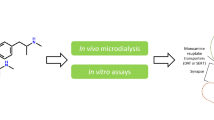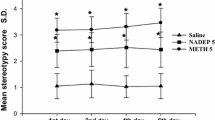Summary
This study investigates the effects of methylenedioxymethamphetamine (MDMA) and amphetamine on monoamine release from rat superfused brain slices in both the presence and absence of vesicular stores of transmitter. MDMA caused the release of radioactivity from slices incubated with [3H]5-hydroxytryptamine, [3H]noradrenaline or [3H]dopamine with EC50 values of 1.9 μmol/l (95% confidence limits 1.5–2.3 μmol/l), 4.5 μmol/l (2.3–8.7 μmol/l), and greater than 30 μmol/l, respectively. In contrast, amphetamine (0.1–300 μmol/l) was more effective in releasing radioactivity from slices incubated with [3H]dopamine than [3H]noradrenaline or [3H]5-hydroxytryptamine. When Ca2+ was excluded from the superfusion fluid, the MDMA induced release of radioactivity from slices incubated with [3H]dopamine was unaltered, but that from slices incubated with [3H]noradrenaline or [3H]5-hydroxytryptamine was enhanced. MDMA (10 μmol/l) facilitated the stimulation-induced (5 Hz, 1 min) outflow of radioactivity from slices incubated with [3H]noradrenaline or [3H]5-hydroxytryptamine to 7.5-fold and 2.1-fold of control values, respectively, but had no effect on that from slices incubated with [3H]dopamine. Amphetamine (1 μmol/l) increased the stimulation-induced outflow from slices incubated with [3H]noradrenaline, but not that from slices incubated with [3H]5-hydroxytryptamine or [3H]dopamine.
Inhibition of monoamine oxidase by a 30-min incubation with pargyline (100 μmol/l) enhanced the releasing action of MDMA on all three monoamines. Pargyline (100 μmol/l) also enhanced the facilitation caused by MDMA, of the stimulation-induced outflow of radioactivity from slices incubated with [3H]noradrenaline, [3H]5-hydroxytryptamine or [3H]dopamine.
In some experiments, slices were obtained from reserpinised rats (2.5 mg/kg s.c. 24 h prior) and pre-exposed for 30 min to the monoamine oxidase inhibitor pargyline (100 μmol/l). Under these conditions, electrical stimulation evoked a small residual stimulation-induced outflow of radioactivity from slices incubated with [3H]noradrenaline, and failed to evoke an outflow of radioactivity from slices incubated with [3H]5-hydroxytryptamine or [3H]dopamine. However, a Ca2+-dependent stimulation-induced outflow of radioactivity was evoked in the presence of either MDMA (10 μmol/l) or amphetamine (1 μmol/l) from slices incubated with either [3H]dopamine or [3H]noradrenaline, but not from slices incubated with [3H]5-hydroxytryptamine. The stimulation-induced outflow of radioactivity from slices incubated with [3H]noradrenaline was enhanced in the presence of desipramine (1 μmol/l), however this enhancement was less than that caused by 10 μmol/l MDMA or 1 μmol/l amphetamine. The Ca2+-dependent response to electrical stimulation in the presence of MDMA from slices incubated with [3H]noradrenaline was greatly reduced when rats were pretreated with a higher dose of reserpine (10 mg/kg s.c.).
This study demonstrates that MDMA and amphetamine release radioactivity from brain slices incubated with [3H]noradrenaline, [3H]dopamine and [3H]5-hydroxytryptamine, but their order or potency as releasers of brain monoamines differs. The results also suggest that MDMA and amphetamine have significant effects on the exocytotic release of monoamines and may interact with both vesicular and cytoplasmic monoamines.
Similar content being viewed by others
References
Arnold EB, Molinoff PB, Rutledge CO (1977) The release of endogenous norepinephrine and dopamine from cerebral cortex by amphetamine. J Pharmacol Exp Ther 202:544–557
Azzaro AJ, Rutledge CO (1973) Selectively of release of norepinephrine, dopamine and 5-hydroxytryptamine by amphetamine in various regions of rat brain. Biochem Pharmacol 22:2801–2813
Barasch JM, Tamir H, Nenez EA, Geshon MD (1987) Serotonin-storing secretory granules from thyroid parafollicular cells J Neurosci 7:4017–4033
Battaglia GA, Yeh SY, O'Hearn E, Molliver ME, Kuhar MJ, DeSouza EB (1987) 3,4-Methylenedioxymethamphetamine and 3,4-methylenedioxyamphetamine destroy serotonin terminals in rat brain; quantification of neurodegeneration by measurement of [3H] paroxetine-labeled serotonin uptake sites. J Pharmacol Exp Ther 242:911–916
Battaglia GA, Brooks BP, Kulsakdinum C, DeSouza EB (1988) Pharmacologic profile of MDMA (3,4-methylenedioxymethamphetamine) at various brain recognition sites. Eur J Pharmacol 149:159–163
Brodie BB, Cho AK, Stefano FJE, Gessa GI (1969) On the mechanism of norepinephrine release by amphetamine and tyramine and tolerance to the effects. Psychopharmacology 1:219–238
Carlsson A (1965) Drugs which block the storage of 5-hydroxytryptamine and related amines. In: Erspamer V (ed) Handbook of experimental pharmacology, vol 19. Springer Berlin Heidelberg New York, pp 529–592
Commins DL, Axt KJ, Vosmer G, Seiden LS (1987a) 5,6-Dihydroxytryptamine, a serotonergic neurotoxin is formed endogenously in the rat brain. Brain Res 403:7–14
Commins DL, Vosmer G, Virus RM, Woolverton WL, Schuster CR, Seiden LS (1987b) Biochemical and histological evidence that methylenedioxymethylamphetamine is toxic to neurons in the rat brain. J Pharmacol Exp Ther 241:338–345
Cubeddu LX, Weiner N (1975) Nerve stimulation-mediated overflow of norepinephrine and dopamine β-hydroxylase. III. Effects of norepinephrine depletion on the alpha presynaptic regulation of release. J Pharmacol Exp Ther 192:1–14
Dahlström A, Jaggendahl J, Atack C (1973) Localization and transport of serotonin. In: Barchas J, Usdin E (eds) Serotonin and behaviour. Academic Press, New York, pp 87–96
Darchen F, Scherman D, Henry JP (1989) Reserpine binding to chromaffin granules suggests the existence of two conformations of the monoamine transporter. Biochemistry 28:1692–1697
Dwoskin LP, Zahniser NR (1986) Robust modulation of [3H]dopamine release from rat striatal slices by D-2 dopamine receptors. J Pharmacol Exp Ther 239:442–453
Fischer JF, Cho AK (1979) Chemical release of dopamine from striatal homogenates: evidence for an exchange diffusion model. J Pharmacol Exp Ther 208:203–209
Fitzgerald JL, Reid JJ (1990) Methylenedioxymethamphetamine (MDMA) has differential effects on monoamine release in rat brain slices. Eur J Pharmacol 191:217–220
Green AL (1971) Inhibition of rat and mouse brain monoamine oxidase by (+)-amphetamine. Biochem J 121:37P–38P
Hekmatpanah CR, Peroutka SJ (1990) 5-Hydroxytryptamine uptake b lockers attenuate the 5-hydroxytryptamine-releasing effect of 3,4-methylenedioxymethamphetamine and related agents. Eur J Pharmacol 177:95–98
Johnson RG, Carty SE, Hayflick S, Scarpa A (1982) Mechanisms of accumulation of tyramine, metaraminol and isopreterenol in isolated chromaffin granules and ghosts. Biochem Pharmacol 31:815–823
Johnson MP, Hoffman AJ, Nichols DE (1986) Effects of the enantiomers of MDA, MDMA and related analogues on [3H]serotonin and [3H]dopamine release from superfused rat brain slices. Eur J Pharmacol 132:269–276
Johnson MP, Conarty PF, Nichols DE (1991) [3H]Monoamine releasing and uptake inhibition properties of 3,4-methylenedioxymethamphetamine and p-chloroamphetamine analogues. Eur J Pharmacol 200:9–16
Kamal L, Arbilla S, Langer SZ (1981) Presynaptic modulation of the release of dopamine from the rabbit caudate nucleus: differences between electrical stimulation, amphetamine and tyramine. J Pharmacol Exp Ther 216:592–598
Kamal LA, Arbilla S, Galzin A-M, Langer SZ (1983) Amphetamine inhibits the electrically evoked release of [3H]dopamine from slices of the rabbit caudate. J Pharmacol Exp Ther 227:446–458
Knoth J, Peabody JO, Huettl P, Njus D (1984) Kinetics of tyramine transport and permeation across chromaffin-vesicle membranes. Biochemistry 23:2011–2016
Lentzen H, Philippu A (1981) Physico-chemical properties of phenylethylamines and their uptake into synaptic vesicles of the caudate nucleus. Biochem Pharmacol 30:1759–1764
Liang NY, Rutledge CO (1982) Evidence for carrier-mediated efflux of dopamine from corpus striatum. Biochem Pharmacol 31: 2479–2484
Maura G, Gemignani A, Versace P, Martire M, Raiteri M (1982) Carrier-mediated and carrier-independent release of serotonin from isolated central nerve endings. Neurochem Int 4:219–224
Mantle TJ, Tipton KF, Garrett NJ (1976) Inhibition of monoamine oxidase by amphetamine and related compounds. Biochem Pharmacol 25:2073–2077
Margquardt GM, DiStefano V, Ling LL (1978) Effects of racemic, (S)-and (R)-methylenedioxyamphetamine on synaptosomal uptake and release of tritiated norepinephrine. Biochem Pharmacol 27: 1497–1501
Masuoka DT, Alcaraz AF, Schott HE (1982) [3H]Dopamine release by d-amphetamine from striatal synaptosomes of reserpinized rats. Biochem Pharmacol 31:1969–1974
Maxwell RA, Ferris RM, Burcsu JE (1976) Structural requirements for inhibition of noradrenaline uptake by phenyethylamine derivatives, desipramine, cocaine, and other compounds. In: Paton DM (ed) The mechanism of neuronal and extraneuronal transport of catecholamines. Raven, New York, pp 95–153
McKenna DJ, Guan X-M, Shulgin AT (1991) 3,4-Methylenedioxyamphetamine (MDA) analogues exhibit differential effects on synaptosomal release of 3H-dopamine and 3H-5-hydroxytryptamine. Pharmacol Biochem Behav 38:505–572
Near JA, Mahler HR (1983) Reserpine labels the catecholamine transporter in synaptic vesicles from bovine caudate nucleus. FEBS Lett 158:31–35
Niddam R, Arbilla S, Scatton B, Dennis T, Langer SZ (1985) Amphetamine induced release of endogenous dopamine in vitro is not reduced following pretreatment with reserpine. Naunyn-Schmiedeberg's Arch Pharmacol 329:123–127
Norn S, Shore PA (1971) Further studies on the nature of persistent reserpine binding: evidence for reversible and irreversible binding. Biochem Pharmacol 20:1291–1295
Parker EM, Cubeddu LX (1986a) Effects of d-amphetamine and dopamine synthesis inhibitors on dopamine and acetylcholine neurotransmission in the striatum. I. Release in the absence of vesicular transmitter stores. J Pharmacol Exp Ther 237:179–192
Parker EM, Cubeddu LX (1986b) Effects of d-amphetamine and dopamine synthesis inhibitors on dopamine and acetylcholine neurotransmission in the striatum. II. Release in the presence of vesicular transmitter stores. J Pharmacol Exp Ther 237;193–203
Parker EM, Cubeddu LX (1988) Comparative effects of amphetamine, phenylethylamine and related drugs on dopamine efflux, dopamine uptake and mazindol binding. J Pharmacol Exp Ther 245:199–210
Paton DM (1976) Characteristics of efflux of noradrenaline from adrenergic neurons. In: Paton DM (ed) The mechanism of neuronal and extraneuronal transport of catecholamines. Raven, New York, pp 49–66
Phillips JH (1982) Dynamic aspects of chromaffin granule structure. Neuroscience 7:1595–1609
Raiteri M, Bertollini A, Angelini F, Levi G (1975) d-Amphetamine as a releaser or reuptake inhibitor of biogenic amines in synaptosomes. Eur J Pharmacol 34:189–195
Raiteri M, Del Carmine R, Bertollini A (1977) Effect of desmethylimipramine on the release of [3H]norepinephrine induced by various agents in hypothalamic synaptosomes. Mol Pharmacol 13:476–758
Raiteri M, Cerrito F, Cervoni AM, Levi G (1979) Dopamine can be released by two mechanisms differentially affected by the dopamine transport inhibitor nomifensine. J Pharmacol Exp Ther 208: 195–202
Russ H, Schömig E, Trendelenburg U (1991) The energy requirements for the basal efflux of 3H-noradrenaline from sympathetically innervated organs. Naunyn-Schmiedeberg's Arch Pharmacol 344:286–296
Scherman D, Henry JP (1984) Reserpine binding to bovine chromaffin granule membranes. Characterization and comparison with dihydrotetrabenazine binding. Mol Pharmacol 25:113–127
Schmidt CJ, Taylor VL (1987) Depression of rat brain tryptophan hydroxylase activity following the acute administration of methylenedioxymethamphetamine. Biochem Pharmacol 336:4095–4102
Schmidt CJ, Levin JA, Lovenberg W (1987) In vitro and in vivo neurochemical effects of methylenedioxymethamphetamine on striatal monoaminergic system in the rat brain. Biochem Pharmacol 36:747–755
Shore PA (1962) Release of serotonin and catecholamines by drugs. Pharmacol Rev 14:531–550
Starke K, Reimann W, Zumstein A, Hertting G (1978) Effect of dopamine receptor agonists and antagonists on release of dopamine in the rabbit caudate nucleus in vitro. Naunyn-Schmiedeberg's Arch Pharmacol 305:27–36
Stone DM, Johnson M, Hanson GR, Gibb JW (1989) Role of endogenous dopamine in the central serotonergic deficits induced by 3,4-methylenedioxymethamphetamine. J Pharmacol Exp Ther 247:79–86
Tamir H, Gershon MD (1987) Serotonin-storing secretory vesicles. In: Johnson RG (ed) Cellular and Molecular Biology of Hormone- and Neurotransmitter-Containing Secretory Vesicles. Ann NY Acad Sci 493:53–67
Thoa NB, Wooten GF, Axelrod J, Kopin IJ (1975) On the mechanisms of release of norepinephrine from sympathetic nerves induced by depolarizing agents and sympathomimetic drugs. Mol Pharmacol 11:10–18
Zaczek R, Culp S, De Souza EB (1990) Intrasynaptosomal sequestration of [3H]amphetamine and [3H]methylenedioxyamphetamine: characterization suggests the presence of a factor responsible for maintaining sequestration. J Neurochem 54:195–204
Zumstein A, Karduck W, Starke K (1981) Pathways of dopamine metabolism in the rabbit caudate nucleus in vitro. Naunyn-Schmiedeberg's Arch Pharmacol 316:205–217
Author information
Authors and Affiliations
Additional information
Correspondence to J. J. Reid at the above address
Rights and permissions
About this article
Cite this article
Fitzgerald, J.L., Reid, J.J. Interactions of methylenedioxymethamphetamine with monoamine transmitter release mechanisms in rat brain slices. Naunyn-Schmiedeberg's Arch Pharmacol 347, 313–323 (1993). https://doi.org/10.1007/BF00167451
Received:
Accepted:
Issue Date:
DOI: https://doi.org/10.1007/BF00167451




